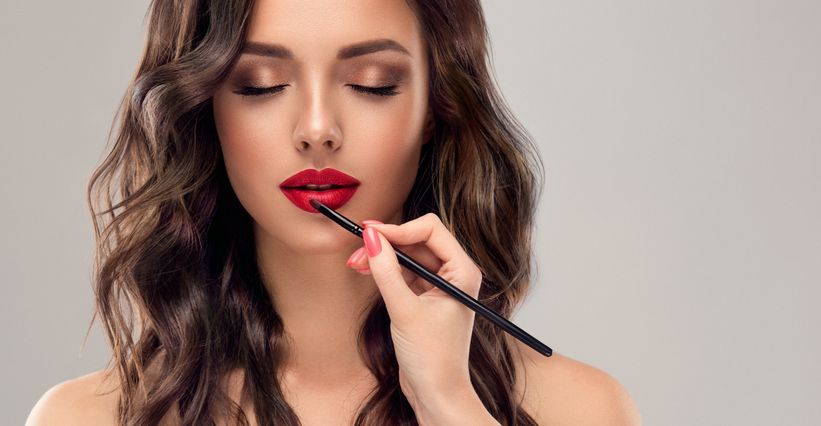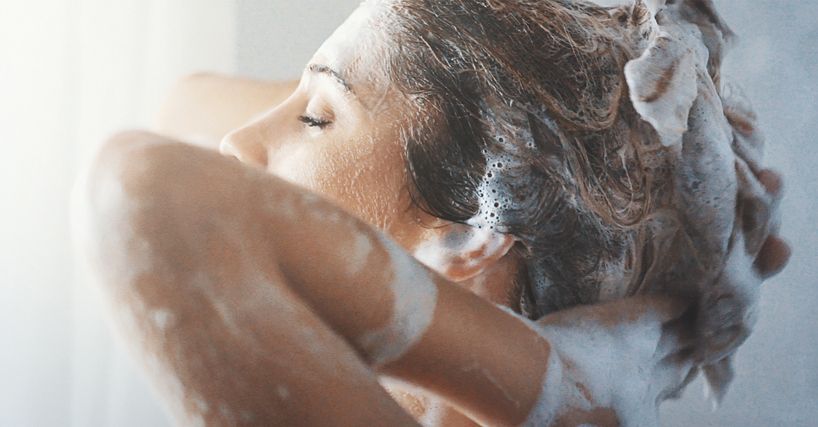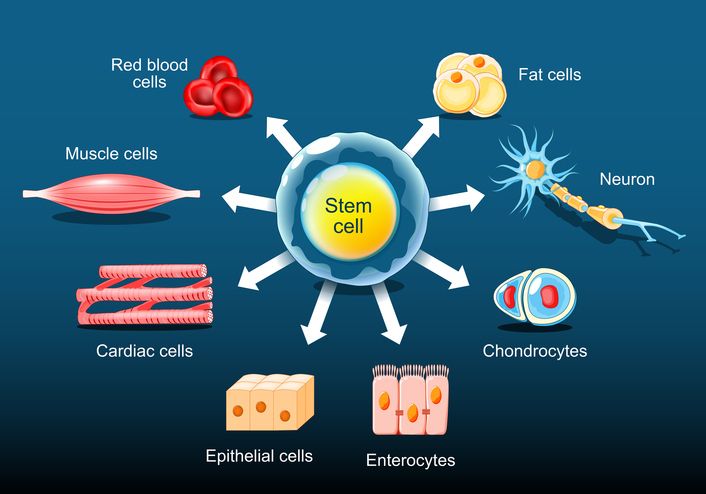Author: Natalie Ng|Updated: 18 June 2025
If you’re noticing acne around your jawline that just won’t go away, your everyday habits might be part of the problem. Things like constantly touching your face, using strong exfoliants too often, or forgetting to clean your phone can quietly add to skin issues. Even your pillowcase, hair products, or what you eat can have a bigger impact on your skin than you’d expect. For those with acne prone skin or dealing with hormonal acne, especially around the chin and jaw, these small triggers can lead to more breakouts over time. Whether it’s related to hormonal fluctuations, PCOS, or just buildup from excess oil and dead skin cells, some habits can make acne harder to deal with, even with a solid skincare routine. Read on to see which skincare and lifestyle habits might be making jawline acne worse, and how small changes could help clear things up.

Touching Your Jawline Frequently Can Trigger Acne

Acne Around Jawline: How Touching Adds Oil and Bacteria to Prone Skin
Touching your jawline is one of several factors that causes jawline acne. Even if it seems harmless, touching your jawline throughout the day can lead to more acne breakouts—especially if you have acne prone skin. Your hands carry oil, bacteria, and dirt that can end up on your face and clog pores. This creates a perfect setup for acne causing bacteria to grow, and the resulting bacterial growth is a key factor that causes jawline acne by leading to skin inflammation and triggering jawline breakouts.
Impact on existing breakouts and acne scars
If you already deal with hormonal acne or adult female acne, touching your skin repeatedly may not cause new breakouts, but it can make existing ones worse. It can also slow healing and increase the risk of acne scars, especially with cystic acne or persistent acne along the jaw.
Ways to avoid jawline contact during the day
You don’t need to avoid touching your face completely, but staying aware of the habit can help. These small changes reduce the chances of clogged pores and inflammation without needing strong acne treatment:
• Wash your hands regularly with soap and water
• Avoid resting your chin on your hand while thinking or working
• Tie back your hair to prevent brushing against your jaw
• Keep your phone screen clean if you often hold it near your face

Heavy Makeup Triggers Breakouts

Thick makeup can trigger jawline acne
Wearing full-coverage foundation every day may seem harmless, but for acne prone skin, it can lead to more clogged pores, especially when combined with poor removal habits. Products that are not non-comedogenic can trap oil, sweat, and dead skin cells against the skin. This buildup can block the hair follicle, contributing to jawline acne by creating an ideal environment for acne causing bacteria to thrive. This buildup contributes to inflammation and makes acne around the jawline worse over time.
If you notice more frequent jawline breakouts or chin acne after wearing makeup regularly, the issue may not be the product itself—but how it interacts with excess sebum production and your daily routine. Increased oil production can worsen the effects of makeup on jawline acne, making breakouts more severe.
Common mistakes that make makeup cause breakouts
• Wearing makeup without skin prep: Applying foundation directly onto bare skin without a gentle cleanser or moisturizer can weaken your skin barrier and make clogged pores more likely. Incorporating gentle cleansing before makeup application helps remove dirt and excess oil without irritation, reducing the risk of breakouts.
• Skipping double cleansing: Using only one cleanser doesn’t fully remove makeup residue, especially if you’re using long-wear or waterproof products.
• Using dirty brushes: Brushes and sponges collect oil, dead skin cells, and bacteria, which can cause acne flares if not cleaned regularly.
• Sleeping with makeup on: Leaving foundation on overnight traps excess oil and prevents your skin from breathing or renewing while you sleep.
Keep acne from getting worse with simple changes
You can still wear makeup with acne prone or oily skin if you follow a few essential steps:
• Choose products labeled as non-comedogenic to avoid clogging pores
• Apply a light, oil-free primer before foundation to protect the skin surface
• Use a gentle cleanser followed by a salicylic acid toner or spot treatment after removal; topical solutions can also be applied to target specific problem areas and support skin healing
• Clean your brushes weekly with mild soap and warm water
• Avoid sharing your products, especially cream-based items
Read More
Book Now to Experience
Acne Treatment
1 Minute Self-Registration
Date should not be before minimal date

Dirty Phone Screens Spread Bacteria to Skin
Phones transfer bacteria to the jawline
Your phone screen may be one of the dirtiest things you touch all day, and it regularly comes into close contact with your face. Each time you take a call, oils, dirt, and acne causing bacteria on the screen can transfer directly to your skin, especially along the jawline and cheek area. For people with acne prone skin, this constant exposure can trigger new breakouts or make existing jawline acne worse.
Throughout the day, your phone collects more than just fingerprints. It picks up makeup residue, dust, sweat, and environmental pollutants. This buildup can irritate the skin and clog pores if your phone isn't cleaned often enough.
Simple steps to avoid acne from phone bacteria
To help reduce acne breakouts linked to phone use, try making these small changes part of your routine:
• Wipe your screen at least twice a day using a microfiber cloth with 70% isopropyl alcohol or a safe electronics disinfectant
• Avoid pressing the phone directly against your skin—use speakerphone or wireless earbuds when possible
• Avoid using your phone with dirty hands or after applying makeup

Unwashed Pillowcases Transfer Oil and Debris
Dirty pillowcases can affect acne on the jawline
Each night, your pillowcase collects oil, sweat, dead skin cells, and residue from hair products. Over time, this buildup creates a surface that can transfer impurities back onto your skin while you sleep. If you have oily skin or acne prone skin, this repeated exposure can lead to clogged pores and increase the chance of jawline breakouts.
While some research suggests your skin can protect itself against common bacteria, the mix of friction, heat, and prolonged contact makes the jawline more vulnerable—especially if you're already dealing with hormonal acne, cystic acne, or acne flares caused by excess oil.
Small changes that help keep pillowcases from causing acne
• Change your pillowcase every 2–3 days if you have acne prone or oily skin
• Use fragrance-free laundry detergent and avoid fabric softeners that may irritate skin
• Try silk or bamboo pillowcases, which absorb less oil and create less friction
• If frequent washing isn’t possible, lay a clean towel over your pillow each night
Book Now to Experience
Acne Treatment
1 Minute Self-Registration
Date should not be before minimal date

Poor Diet and Low Hydration Affects Skin Health
Diet and hydration affect jawline breakouts
What you eat and drink every day can affect your skin more than you might think. Diets high in sugar, processed foods, and dairy may trigger hormonal fluctuations that lead to jawline acne, especially for people with adult acne or polycystic ovary syndrome (PCOS). These dietary factors can contribute to hormonal changes and hormonal shifts, both of which are linked to jawline acne. When your body experiences spikes in blood sugar or stress hormone levels, sebum production often increases, raising the risk of clogged pores and acne flare ups. Hormonal changes, including those related to menstrual periods and male hormones, can also play a significant role in jawline acne.
Lack of water can also impact the skin barrier. Dehydrated skin struggles to shed dead skin cells properly, which can lead to buildup around hair follicles and more frequent breakouts.
Daily habits that help support clear skin
• Drink 8–10 glasses of water throughout the day to help flush out toxins and support your skin’s natural barrier
• Limit added sugar to under 25 grams daily, especially from processed snacks or sweetened drinks
• Avoid excessive dairy or greasy foods, which may make hormonal breakouts worse
• Aim for a balanced diet rich in whole foods like leafy greens, fruit, fish, and healthy fats
• These daily habits can help prevent acne, especially along the jawline, by supporting overall skin health and reducing the risk of breakouts

Harsh Scrubs Damage the Skin Barrier
Rough scrubs can damage your skin barrier
Exfoliating is meant to help unclog pores and remove dead skin cells, but using gritty scrubs with large or jagged particles can do more harm than good. These physical exfoliants can cause micro-tears in the skin, leading to irritation, inflammation, and even the spread of acne causing bacteria. This is especially risky for acne prone skin or those already dealing with hormonal breakouts around the jawline.
Instead of helping clear acne on jawline areas, aggressive scrubbing can disrupt the skin barrier, making acne worse and slowing healing—especially if you're dealing with stubborn acne or cystic acne.
Switch to gentle exfoliation with better ingredients
For treating acne effectively, swap physical scrubs for chemical exfoliants that work without causing trauma to the skin:
• Use chemical exfoliants with ingredients like salicylic acid, lactic acid, or azelaic acid
• Exfoliate only 2–3 times per week to avoid over-stripping the skin
• Apply with clean hands and use light, circular motions for no more than 30 seconds
• Follow up with a gentle cleanser and non-comedogenic moisturizer to support the skin barrier
Book Now to Experience
Acne Treatment
1 Minute Self-Registration
Date should not be before minimal date

Sweat Left on Skin After Workouts Clogs Pores
Sweat buildup leads to clogged pores
Sweating during workouts is healthy, but if it stays on your skin too long, it can trap bacteria, dirt, and oil—especially around the jawline where sweat often collects. For acne prone skin, this can quickly lead to clogged pores and flare ups. If you're dealing with hormonal acne or persistent acne on jawline areas, sweat left on the skin after exercise can make things worse by creating the perfect environment for acne causing bacteria.
The warm, moist conditions from post-workout sweat can also increase irritation, especially if you wear tight workout clothing or touch your face with dirty gym towels.
Post-workout habits that reduce acne flare ups
• Gently blot sweat with a clean towel during exercise—avoid wiping, which spreads bacteria
• Change out of sweaty clothes as soon as possible, ideally within 15–20 minutes
• Wash your face with a gentle cleanser shortly after your workout
• Keep non-comedogenic cleansing wipes in your gym bag if you can’t shower right away

Hair Products Leave Behind Pore-Clogging Residue
Hair product residue can clog pores along the jawline
Many shampoos, conditioners, and styling products contain oils, silicones, and other ingredients that aren’t made for skin contact. When these products drip down or rub against your jawline, they can leave behind residue that clogs pores and increases the risk of developing jawline acne—especially if you have acne prone or oily skin.
This is especially common during and after hair washing or while applying leave-in treatments and sprays. If you’re already experiencing hormonal breakouts or skin inflammation, product buildup from hair care can make acne worse or slow healing.
Ways to prevent hair products from irritating your skin
• Tilt your head to the side while rinsing your hair so water and products run away from your face
• Use a towel to wrap your hair right after washing to avoid dripping onto your jaw and neck
• Apply styling products while leaning forward to keep them off your skin
• Place a clean towel over your neck and jaw while styling to create a barrier
Book Now to Experience
Acne Treatment
1 Minute Self-Registration
Date should not be before minimal date

Tight Clothing and Masks Irritate the Lower Face
Friction and trapped bacteria irritate the jawline
Clothing and accessories that press tightly against your jawline—like turtlenecks, scarves, or face masks—can trap sweat, oil, and acne causing bacteria against the skin. Over time, this friction and buildup can lead to clogged pores and inflamed breakouts, especially for people prone to acne mechanica or those already experiencing hormonal acne around the jaw and chin.
Face masks, in particular, can create a warm, humid environment that disrupts the skin barrier. When worn for long hours without breaks or proper cleansing, they can worsen existing jawline acne and even trigger new acne flare ups.
Reduce acne flare ups with simple fabric and hygiene choices
• Wear breathable fabrics like cotton or bamboo and avoid re-wearing unwashed scarves or collars
• Change face masks every 4 hours, or sooner if they become damp
• Wash reusable masks with a gentle detergent and dry them fully before use
• Apply a light, non-comedogenic moisturizer before wearing masks to reduce friction

Signs That Acne on the Jawline Is Linked to Hormonal Imbalance
Common Patterns of Hormonal Breakouts
Not all acne is caused by surface habits. If you’re noticing persistent acne around the jawline, chin, or lower cheeks, it could be a sign of hormonal imbalance. Unlike random breakouts, hormonal acne often follows a pattern and tends to resist typical over-the-counter treatments. It can appear as deep, painful bumps or cysts that come back in the same area each month.
You may also notice breakouts linked to your menstrual cycle, stress, or signs of polycystic ovary syndrome (PCOS) such as irregular periods, weight gain, or excess facial hair. These symptoms suggest that internal hormone shifts—rather than clogged pores alone—are contributing to your acne flare ups. Hormonal imbalances, including those involving the adrenal glands, can increase androgen production or sensitivity, which plays a significant role in jawline acne.
Treatment Options for Hormonal Acne
If your acne is showing these signs, it may be time to move beyond spot treatments and look at medical options. A variety of acne treatments are available, and working with a professional to develop a personalized treatment plan is important for achieving the best results. These may include:
• Oral contraceptives (birth control pills) to help regulate hormonal fluctuations
• Hormonal therapy for PCOS or adrenal imbalance
• Oral medications like spironolactone or oral isotretinoin for severe acne
• A dermatologist-guided skincare routine that includes azelaic acid, topical retinoids, or gentle chemical peels
Advanced options such as laser therapy can also be considered for stubborn or scarred jawline acne.
Recognizing the signs early can save time, prevent scarring, and lead to more targeted acne treatment—especially for those managing adult female acne or cystic breakouts on the jawline.
Book Now to Experience
Acne Treatment
1 Minute Self-Registration
Date should not be before minimal date

Mistakes That Can Make Jawline Acne Worse
Overcorrecting your skincare routine
When breakouts won’t go away, it’s easy to feel like you need to do more. But using too many active ingredients, layering strong exfoliants, or constantly switching products can do more harm than good. Overusing topical treatments—especially harsh ones like benzoyl peroxide or chemical peels—can strip the skin barrier and trigger more inflammation, which only worsens acne flare ups around the jawline.
Picking or squeezing breakouts
Trying to manually remove pimples or blackheads may feel satisfying, but it often pushes bacteria deeper into the skin. This increases the risk of developing acne scars, especially with cystic acne along the jawline. For acne prone skin, picking even small blemishes can delay healing and lead to more redness and swelling.
Relying only on spot treatments
Spot treatments can help in some cases, but if you’re getting repeated breakouts in the same area—like chin acne or jawline acne—it’s a sign the cause is deeper. Hormonal fluctuations, excess sebum production, or buildup inside clogged pores require full-face or targeted treatments to manage the root of the issue. Relying solely on drying agents might reduce swelling temporarily but won’t prevent future acne flare ups.

Targeted Treatment That Helps Clear Jawline Acne Faster
Professional care for stubborn jawline breakouts
If you’ve already adjusted your skincare and daily habits but still deal with acne around the jawline, you’re not alone. Jawline acne, especially when linked to hormonal fluctuations or clogged pores, often needs more than topical products to calm inflammation and prevent breakouts from coming back. That’s where a treatment like the Acne Treatment can support your skin more deeply.
This non-invasive treatment is designed specifically for acne prone skin, and works by deeply cleansing the pores while calming overactive sebaceous glands. It combines vacuum microdermabrasion with a hydrating serum infusion—two steps that help reduce acne causing bacteria, exfoliate dead skin cells, and balance oil levels below the surface.
How the Acne Treatment works
• A dual spiral suction probe gently exfoliates and removes dead skin cells, dirt, and excess oil trapped in clogged pores—especially around the chin and jawline
• At the same time, the suction drains buildup that causes inflammation, helping to calm active jawline breakouts
• Once the pores are cleared, a medical-grade hydrating serum is infused into the skin to restore balance, prevent excess sebum production, and promote healing
• This step also helps soothe irritated skin and improve the look of acne scars and uneven texture caused by previous breakouts
Why this treatment supports clearer, healthier skin
• Non-invasive: No needles, downtime, or medication
• Targets multiple causes of jawline acne: From excess oil to dead skin cells and bacteria buildup
• Supports long-term results: With regular sessions, it can help reduce future acne flare ups and promote a more even, hydrated skin tone
• Safe for sensitive or hormonal acne: Ideal for those with adult female acne, cystic acne, or recurring chin acne linked to hormonal imbalance
If you're dealing with persistent acne on the jawline that doesn’t respond well to cleansers or spot treatments alone, this treatment can help improve your skin from the inside out.
Book a consultation today to see how the Acne Treatment can support your skincare routine and help you achieve smoother, clearer skin—especially in stubborn areas like the jawline.
New Beauty's Acne TreatmentBook Now to Experience
Acne Treatment
1 Minute Self-Registration
Date should not be before minimal date
FAQ
Can stress cause acne around the jawline?
Yes. When you're under stress, your body releases more cortisol—a stress hormone that can increase sebum production. For acne prone skin, this extra oil can clog pores and create the right environment for acne causing bacteria to thrive. Jawline breakouts linked to stress often show up in the same areas repeatedly and may worsen during emotionally demanding periods.
Does shaving contribute to jawline acne in men?
Shaving can trigger jawline acne in some men, especially if the skin is already sensitive or prone to clogged pores. Using dull blades, applying harsh shaving cream, or shaving against the grain can irritate the skin and hair follicles, leading to acne flare ups or inflamed bumps. To reduce irritation, use a clean razor, apply a gentle cleanser before shaving, and avoid aftershaves with alcohol.
Can sleeping position affect acne on jawline?
Yes. If you sleep on your side or stomach, your jawline may press against your pillow for hours, trapping heat, sweat, and bacteria near your skin. This can lead to clogged pores and acne breakouts, especially if pillowcases aren't changed often. For those with oily skin or frequent jawline acne, switching to a clean pillowcase every few days and sleeping on your back when possible may help.
Are oral medications always necessary for hormonal jawline acne?
Not always. While oral medications like oral contraceptives or spironolactone can help treat hormonal imbalance and reduce cystic acne, they're not the only option. Topical treatments like azelaic acid, salicylic acid, or topical retinoids can also help reduce inflammation and unclog pores. The best approach depends on the severity of the acne, the individual’s health history, and how the skin responds to treatment.
Is jawline acne linked to digestive health?
Emerging research suggests a possible link between digestive issues and acne around the jawline. An imbalanced gut microbiome or food sensitivities may trigger skin inflammation or hormonal fluctuations, which can lead to acne breakouts. While the connection isn't fully proven, some people find that reducing processed foods, increasing fiber, and avoiding trigger foods like dairy helps reduce acne flare ups and support healthy skin.
Recommended Articles
COPYRIGHT© NEW BEAUTY MANAGEMENT LIMITED 2025. ALL RIGHT RESERVED.




